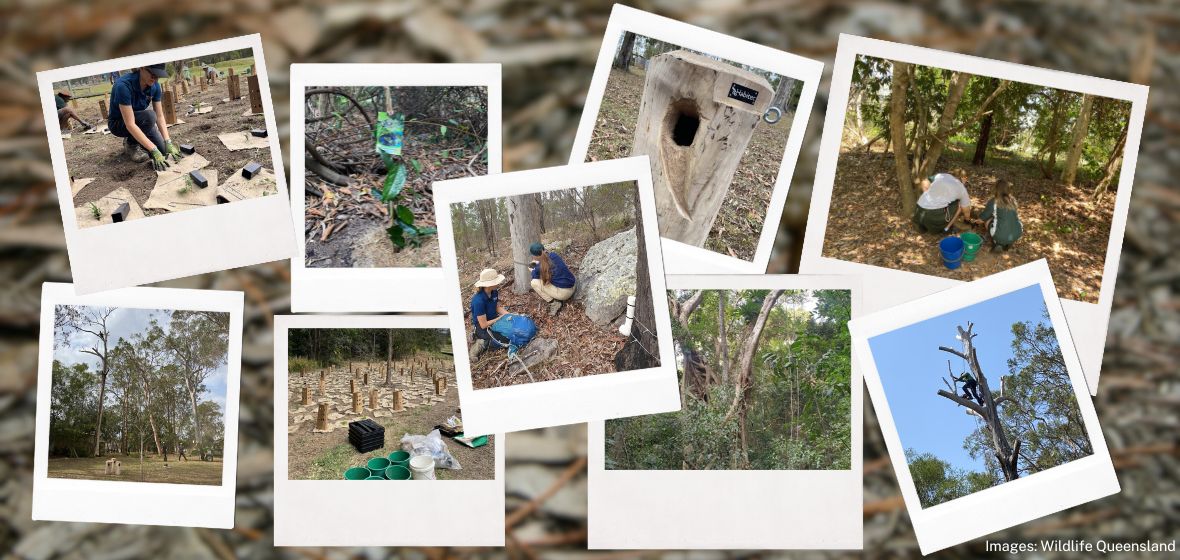22 December 2023
Wildlife Queensland project officer Hannah Thomas has been involved in several projects in South East Queensland these past few months. She has been busy gathering spotted-tailed quoll data, planting platypus habitat, creating butterfly corridors, and installing greater glider hollows.
Looking for spotted-tailed quolls
One project involved setting up cameras on private properties in Logan West to monitor the elusive spotted-tailed quoll (Dasyurus maculatus maculatus), currently listed as endangered under the Environment Protection and Biodiversity Conservation (EBPC) Act 1999. Financed by the Logan City Council through its EnviroGrants funding program, the project aimed to contribute to understanding quoll populations in the area.
Five private properties were selected for camera installation, with approximately five cameras deployed per property. Despite the absence of quoll detections, the cameras captured many images highlighting the region’s biodiversity. The data analysis, assisted by dedicated volunteers, revealed 58 native species:
- 21 bird species, including a scarlet honeyeater (Myzomela sanguinolenta) and five regent bowerbirds (Sericulus chrysocephalus)
- snakes, including a carpet python (Morelia spilota), a green tree snake (Dendrelaphis punctulata) and an eastern brown snake (Pseudonaja textiles)
- a koala (Phascolarctos cinereus).

Camera trap image of koala at night. Image: Wildlife Queensland

Camera trap image of a carpet python. Image: Wildlife Queensland
“These results show how important private land conservation is in South East Queensland and that we have a lot to do if we want to be able to share our bushland areas with a healthy population of spotted-tailed quolls,” said Hannah.
Revegetation helps creek health and butterfly corridor
The PlatypusWatch team contributed to the expansion of riparian vegetation along the banks of Windaroo Creek at Noyer Park in Logan. They planted 500 native trees and shrubs, emphasising the critical role of riparian vegetation in maintaining the health of creeks and waterways, which is essential for species like the platypus.
Hannah assisted Year 11 students from Windaroo Valley State School in planting Richmond birdwing butterfly vines along Windaroo Creek’s banks. The initiative, part of a broader effort to create a butterfly corridor within the Albert River catchment, aims to support the unique dietary needs of birdwing butterfly caterpillars. Wildlife Queensland invites individuals interested in contributing to the cause to plant birdwing butterfly vines in their backyard.
Creating homes for Logan’s greater gliders
Wildlife Queensland was involved in a greater glider conservation initiative at Chambers Flat, Logan. This project, supported by Logan City Council EnviroGrant funding, addressed the competition for hollows faced by greater gliders from various bird species.
In collaboration with Habi-tec, the team installed twenty greater glider-suitable hollows across five properties, documenting animal movements through strategically placed cameras. Some local Land for Wildlife members were concerned that greater gliders face much competition for hollows on their property from birds such as sulphur-crested cockatoos and brushtail possums.
Habi-tec installed eighteen nest boxes carved from salvaged wood, thus closely resembling the conditions of a natural hollow. They also installed two carved hollows in a suitable large, old Eucalyptus stag that lightning had struck. Cameras were installed on one of the carved hollows and one of the nest boxes to observe animal movements.
The project yielded positive results, capturing the attention of smaller gliders and birds, with the exciting sighting of a greater glider exploring one of the newly installed nest boxes. Wildlife Queensland eagerly awaits more footage to see if the greater gliders start to use the nest box regularly.
Wildlife Queensland’s conservation projects confirm that collaborations help protect and improve the rich biodiversity in South East Queensland.
“We’re thrilled to involve local communities in these conservation efforts, encouraging everyone to contribute to preserving our natural heritage,” Hannah shared.
What you can do
- Watch our new presentation about spotted-tailed quolls on our Quoll Seekers Network page.
- Donate to help fund our new greater glider project, investigating behaviour and habitat preferences so we can take proactive measures if their habitat is pressured or destroyed.
- Plant a birdwing butterfly vine and help bring back the endangered Richmond birdwing butterfly. Vines are available from our shop – pick-up only.
- Help support our projects by symbolically adopting either a glider, a platypus, a spotted-tailed quoll, a Richmond birdwing butterfly or a brush-tailed rock wallaby for one year with a tax-deductible donation.

